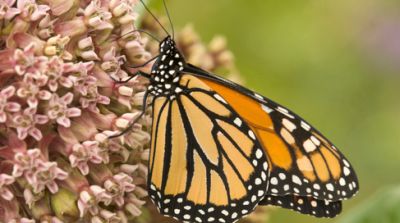Please join CFS in urging the FWS to protect monarch butterflies!
 Monarch butterflies are one of the most beautiful and iconic insects in the world, and they are in serious trouble. The monarch butterfly population in North America has been shrinking at an alarming rate. Why? A major culprit is the use of herbicides like Monsanto’s Roundup on genetically engineered (GE) crops, which is destroying a significant portion of their breeding habitat.
Monarch butterflies are one of the most beautiful and iconic insects in the world, and they are in serious trouble. The monarch butterfly population in North America has been shrinking at an alarming rate. Why? A major culprit is the use of herbicides like Monsanto’s Roundup on genetically engineered (GE) crops, which is destroying a significant portion of their breeding habitat.
That’s why Center for Food Safety and Center for Biological Diversity have just co-filed a groundbreaking legal petition–joined by Xerces Society and renowned monarch scientist Prof. Lincoln Brower–to list the monarch butterfly as a threatened species under the Endangered Species Act (ESA).If listed, the U.S. government would be required to take urgent and significant action to protect monarchs from further declines.
We all know that Monsanto’s genetically engineered crops and the pesticides they promote can wreak havoc on our farms, food, and environment. But what many people may not know is that they are also playing a big role in the rapid disappearance of monarchs.
Herbicides like Roundup don’t kill monarchs directly, but rather kill their primary food source and habitat. Milkweeds are critical to the monarch’s survival because they are the only plants monarch caterpillars will eat. But thanks to the rampant use of Roundup on Monsanto’s genetically engineered crops, milkweed plants in the heart of the monarch’s range have been demolished. Fewer milkweeds mean fewer Monarchs.
So we are faced with a historic choice: Do we want Monsanto or monarchs? It is becoming increasingly clear that we cannot have both. To protect monarchs we must protect and reclaim their critical habitat, and reject Monsanto’s Roundup Ready GE crops, and the unsustainable, pesticide-intensive, industrial agriculture system promoted by them.
Though there are some good voluntary programs to restore milkweeds and protect monarchs, there are no mandatory regulatory mechanisms that adequately protect the monarch butterfly. Listing monarchs under the ESA will ensure that these iconic butterflies get the protection they need.
Please join CFS in urging the FWS to protect monarch butterflies!
More information:
- Center for Food Safety, Center for Biological Diversity: Petition to Protect The Monarch Butterfly (Danus Plexippus Plexippus) Under the Endangered Species Act (8/27/14)
- Center for Food Safety, Center for Biological Diversity: FAQs on the Monarch Butterfly Endangered Species Act Petition (8/27/14)
- Robbins, J. (2013, November 22). The Year the Monarch Didn’t Appear. The New York Times.
- Center for Food Safety, Monarchs & Pesticides; Monarch Decline & GE Crops
- Center for Food Safety, Monarch Breeding & Glyphosate Use Maps
